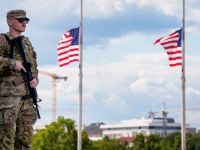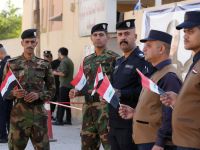US Secretary of State Madeleine Albright, the highest-ranking US official ever to visit North Korea, Monday met with North Korean leader Kim Jong-Il.
Following is a chronology of major events between the United States, South and North Korea:
Aug 1945: The Korean peninsula is divided into communist North and capitalist South Korea at the end of World War II. US troops move into South Korea.
Sept 1948: The Soviet-backed Democratic People's Republic of Korea (North Korea) is formally founded with Kim Il-Sung as leader.
June 1949: US troops leave South Korea, after Soviet forces left the North, but civil war breaks out with clashes along the frontier.
June 1950: North Korean troops invade the South, sparking the Korean War.
July 1953: North Korea signs a ceasefire agreement with the United States, ending the Korean War, which left more than three million people dead or missing -- including up to 2.4 million Koreans, 900,000 Chinese and about 40,000 Americans. No formal peace treaty is signed, leaving the two sides technically at war.
June 1968: North Korea seizes a US spy boat and its crew. US war ships and an aircraft career are dispatched and anchored near North Korean waters in a show of force.
Aug 1976: North Korea hacks two US soldiers to death in the truce village of Panmunjom, raising tensions on the Korean border.
June 1994: Former US president Jimmy Carter visits North Korea and Kim Il-Sung proposes a Korean summit.
July 1994: Kim Il-Sung dies before the summit can go ahead.
Oct 1994: North Korea and the United States sign a nuclear deal in Geneva in which Pyongyang agrees to freeze its nuclear program.
April 1996: The United States and North Korea start talks on the North's missile program.
Aug 1998: North Korea test-fires a Taepo-dong 1 ballistic missile over Japan, sparking international alarm.
May 1999: US special envoy William Perry visits Pyongyang to discuss a peace process on the Korean peninsula.
Sept 1999: The United States announces a partial lifting of its economic sanctions against North Korea.
June 2000: President Kim Dae-Jung and Kim Jong-Il sign a landmark reconciliation accord at a historic inter-Korean summit in Pyongyang.
July: The United States and North Korea hold their first foreign ministers' meeting during a regional security forum in Bangkok.
Oct 6: President Clinton emphasizes the importance of reconciliation with North Korea, and North Korea agrees with the US anti-terrorism message, acknowledging that terrorism endangers world peace.
Oct 9-12: North Korea's Vice Marshal Jo Myong-Rok, one of Kim Jong Il's key aides, meets President Bill Clinton on an official visit to Washington, the first such visit of a high-ranking North Korean official. The two countries issue a joint communiqué on improving relations, ending the decades of hostility by ensuring peace between North and South Korea and throughout the region, and discuss a "possible" visit by Clinton
Oct 23: US Secretary of State, Madeleine Albright, arrives in Pyongyang -- the highest-ranking US official to visit North Korea.
She holds talks with Kim Jong-Il in his first encounter with a US official -- SEOUL (AFP)
© 2000 Al Bawaba (www.albawaba.com)







